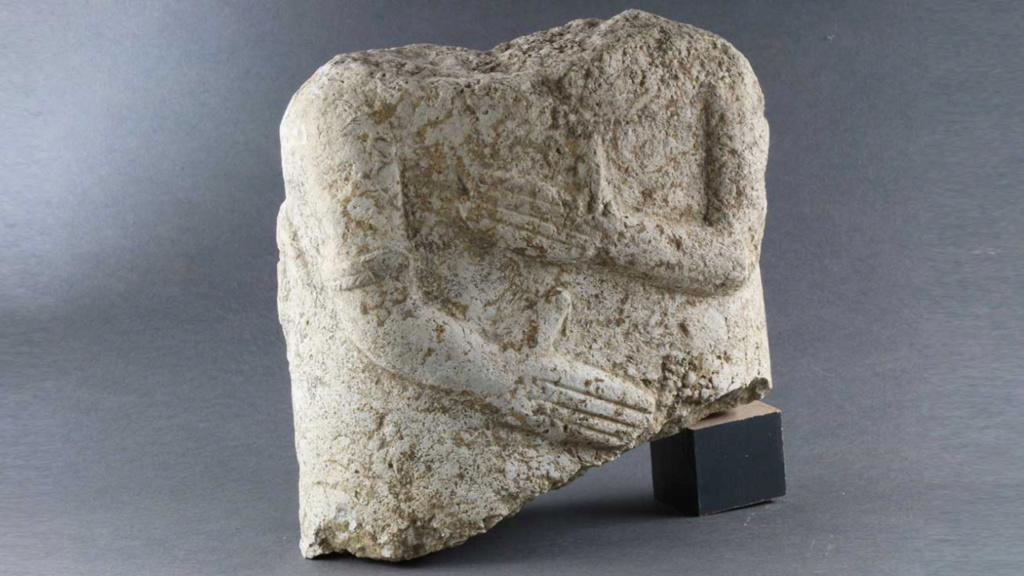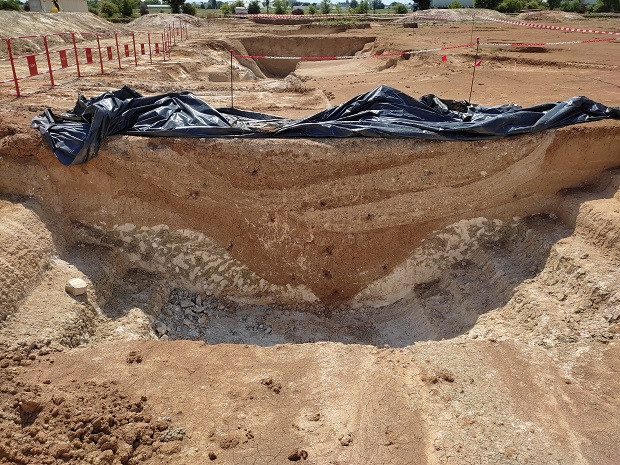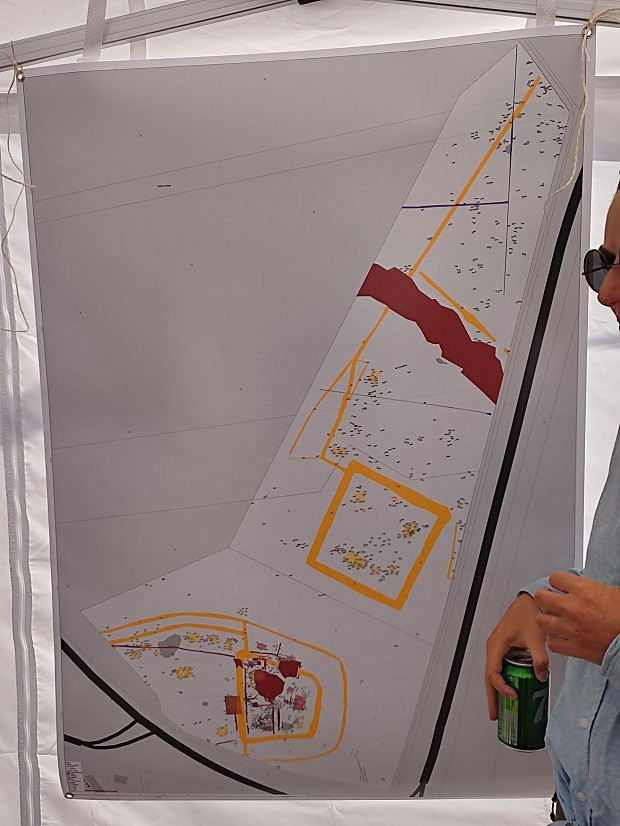Archéologie : découverte exceptionnelle de statues gauloises et d’une tombe néolithique à Artenay

Detail views of a fragment of a Celtic-style statue, representing a human torso. On the back are carved two animals in full combat. This association of anthropomorphic and zoomorphic representations is extremely rare
On the archaeological site of Artenay, in the Centre-Val de Loire region, Inrap researchers recently discovered a huge rural complex from the Gallic era. Among the unearthed remains of structures are two intriguing statues. A very special Neolithic tomb also caught their attention.
On the site of Artenay, near Orléans, several centuries of history intertwine, from the Neolithic to Roman Gaul. In this 9-hectare space, investigated since August 2020, archaeologists from the National Institute for Preventive Archaeological Research (Inrap) discovered two agricultural complexes from the Gallic era , surrounded by deep ditches, each including an aristocratic residence. These sets revealed two fragments of statues , which is very rare as far as Gaul is concerned, especially in this region. A Neolithic tomb, containing a skeleton in a fetal position clutching an antler, was also unearthed. This huge site, which will soon host the ZAC d'Artenay-Poupry, raises many questionsto archaeologists, in particular on the links between the two Gallic farms.
Gallic aristocrats
The main discovery of the site focuses on the Gallic rural complex. These are two large farms, 7,200 and 4,300 m², separated by barely 50 meters. Simultaneously occupied from the 1st century BC. AD to the 2nd century AD. AD, they were revealed by the traces left by the large wooden posts used in the Gallic constructions and by the ditches dug to delimit these properties. The Gallic lords of the time, who based their wealth on farming, did in fact build vast ditches which, if they did not stop possible enemies, made it possible to assert their prestige. This is particularly visible in the fact that the ditches are much deeper at the entrance to the farms than at the other ends.

We can see here the slope of the ditch, dug in the limestone by Gallic workers or slaves. The different observable layers correspond to the progressive backfilling of the ditch by the occupants with the earth from the adjacent embankment, which was on the right.
With the earth extracted from these ditches, an embankment, probably vegetated, was erected within the confines of the fief to protect it from assailants and the wind. Within these complexes, there was both a vast residence, which suggests that the masters of the place were particularly powerful, a series of cellars used to temporarily store food and workshops, ovens and dwellings which probably housed families working for the head of the estate. According to Jean-Philippe Gai, the archaeologist responsible for the excavation operation, the influence of Rome is already felt on this site, particularly in terms of the organization of spaces, which recalls that of Roman villas.

Plan showing the extent of the archaeological site. The areas in yellow correspond to the remains of the Gallic period and the areas in red to those of the Roman period
Multiple questions
The high concentrations of phosphate in the soils have, moreover, made it possible to confirm that these were indeed farms. The study of the seeds found at the bottom of the silos of the time has shown that the Gauls practiced the "double harvest", that is to say that they harvested their cereals, mainly spelled and wheat, twice a year. This very important productivity (which was thought to have been invented in modern times) allowed the Gauls to be extremely prosperous and to export their crops as far as Rome.

The two circles that can be observed in the earth in this image show the location of a large wooden post used to support the Gaulish cob structures
And the Artenay site has not finished surprising us. In particular, the archaeologists are seeking to determine why two agricultural enclosures, which often marked the domination of a chief over a territory of around one square kilometer, which have their backs to each other and one of which seems slightly older than the other, have coexisted in such a small space. The researchers believe that it is possible that they belonged to the same chief but performed different functions. Finally, if they experienced several devastating fires, which gave rise to various reconstructions, these would not explain the desertion of the two camps, the cause of which remains to be determined.

This more rocky pile shows that the wooden post that was in this hole was consumed and that the structure collapsed, filling the hole with pieces of cob
An exceptional statuary
Beyond numerous pieces of ceramics, two remarkable fragments of statues from the Gallic period were also found by archaeologists. The first is a Celtic-style bust, the head and bottom of which have been broken off, and which shows a figure with hands placed on his stomach, with a typical Gallic armband. On his back, two animals, which could be stags or rams, have been depicted fighting. This piece of carved limestone is unique, there is no similar one in the Centre-Val de Loire region, the majority of Gallic statues having been discovered in Brittany. Moreover, it is one of the only representations of the time combining both humans and animals. Her features seem to link her to a German sculptural style, characterized in particular by the elongation of the limbs and the position of the thumbs, but four centuries earlier than the dating of the statue, which strongly questions researchers.

This type of sculpture is extremely rare, particularly in the Centre-Val de Loire region.
The second statue fragment is a terracotta head, which probably belonged to a larger sculpture. The eyes and ears are very prominent and also bring it closer to the Celtic style. There is no equivalent of this object elsewhere in France, but it has characteristics similar to those of four first-century busts unearthed in October 2019 at Trémuson in Brittany. These two discoveries are very surprising and shrouded in mystery. Who are the characters depicted? Are they deities, illustrious Gauls or masters of the place? Were they intentionally broken? If so, why and if not, where are the other fragments? Why were they thrown into a ditch? Post-excavation studies by Inrap will no doubt shed light on these gray areas.

This terracotta head has characteristics similar to other busts discovered in Brittany
Prehistoric discoveries
In addition to an area rich in flint, which probably housed tool cutters during prehistory, Inrap researchers have unearthed two exceptional burials dating from between 5500 and 3700 BC. In one of them, a very particular skeleton was discovered. In the fetal position, the man holds in his arms a perforated deer antler and had a polished ax, used for felling trees, placed under his head. Called adze, this tool was still placed in a sheath, also made of deer antler. Among the other Neolithic burials, which generally have few individual characteristics, the tomb of Artenay is an exception here.

Aerial view of the first zone of the Artenay archaeological site
If you want to learn more about these discoveries but also about the profession and techniques of archaeologists in general, they are mobilized from June 18 to 20 to present these unique remains, on the occasion of the European Days of Archeology. .
Source : websites

